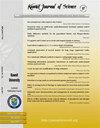Impact of coronavirus disease (COVID-19) on gaseous pollutants and particulate matter in a hot arid climate
IF 1.2
4区 综合性期刊
Q3 MULTIDISCIPLINARY SCIENCES
引用次数: 0
Abstract
The outbreak of the coronavirus disease (COVID-19) has had a significant impact on the global community, affecting various aspects of life. One of the unintended consequences of the pandemic is its effect on air quality. This study uses the state of Kuwait as a case study to investigate the impact of the COVID-19 pandemic on levels of gaseous pollutants (NO2, O3, SO2, H2S, CO) and particulate matter 2.5 and 10 μm (PM2.5 and PM10) in a hot arid region. Hourly data for COVID-19 infected cases and gaseous pollutants and particulate matter were collected from January to December 2020. The Openair model with the R package was used to analyze gaseous pollutants and particulate matter data with an applied air quality index (AQI). Stochastic models with time series analysis - Kernel density were employed to investigate how COVID-19 infection can affect the changes of gaseous pollutants and particulate matter. In addition, the spatial interpolation approach was estimated using the inverse distance weighted (IDW). The Generalized Additive Model (GAM) was used to analyze the daily data of the gasses and particle occurrences in a hot, dry climate. The results showed a significant decrease in levels of gaseous pollutants and particulate matter after implementing preventive measures to control the spread of the virus. This reduction benefits public health and the environment in the region, indicating that the preventive measures taken to address the COVID-19 pandemic have contributed to reducing environmental pollution and mitigating its adverse effects.
冠状病毒病(COVID-19)对炎热干旱气候下气态污染物和颗粒物的影响
冠状病毒病(COVID-19)的爆发对全球社会产生了重大影响,影响到生活的各个方面。大流行的意外后果之一是它对空气质量的影响。本研究以科威特为例,调查了COVID-19大流行对炎热干旱地区气态污染物(NO2、O3、SO2、H2S、CO)和颗粒物质2.5和10 μm (PM2.5和PM10)水平的影响。收集2020年1月至12月COVID-19感染病例、气体污染物和颗粒物的每小时数据。使用带有R包的Openair模型,利用应用空气质量指数(AQI)分析气态污染物和颗粒物数据。采用随机时间序列模型-核密度分析,研究COVID-19感染对气体污染物和颗粒物变化的影响。此外,利用距离逆加权(IDW)对空间插值方法进行了估计。采用广义加性模型(GAM)分析了炎热干燥气候下的气体和颗粒的日数据。结果显示,在实施控制病毒传播的预防措施后,气态污染物和颗粒物的水平显著下降。这一减少有利于该地区的公共卫生和环境,表明为应对COVID-19大流行而采取的预防措施有助于减少环境污染并减轻其不利影响。
本文章由计算机程序翻译,如有差异,请以英文原文为准。
求助全文
约1分钟内获得全文
求助全文
来源期刊

Kuwait Journal of Science
MULTIDISCIPLINARY SCIENCES-
CiteScore
1.60
自引率
28.60%
发文量
132
期刊介绍:
Kuwait Journal of Science (KJS) is indexed and abstracted by major publishing houses such as Chemical Abstract, Science Citation Index, Current contents, Mathematics Abstract, Micribiological Abstracts etc. KJS publishes peer-review articles in various fields of Science including Mathematics, Computer Science, Physics, Statistics, Biology, Chemistry and Earth & Environmental Sciences. In addition, it also aims to bring the results of scientific research carried out under a variety of intellectual traditions and organizations to the attention of specialized scholarly readership. As such, the publisher expects the submission of original manuscripts which contain analysis and solutions about important theoretical, empirical and normative issues.
 求助内容:
求助内容: 应助结果提醒方式:
应助结果提醒方式:


